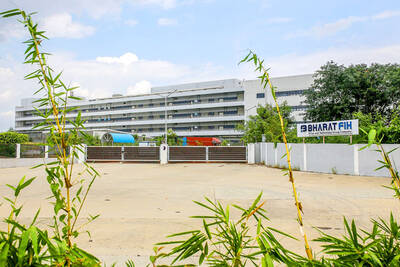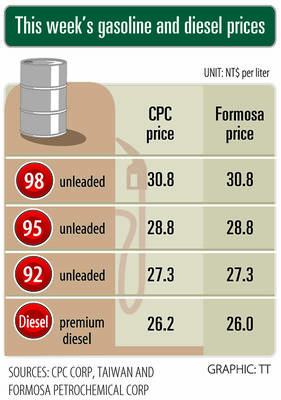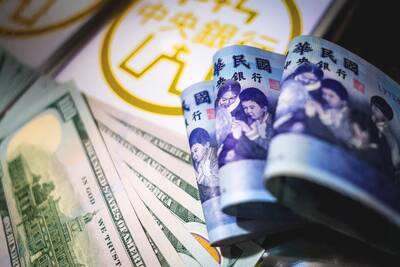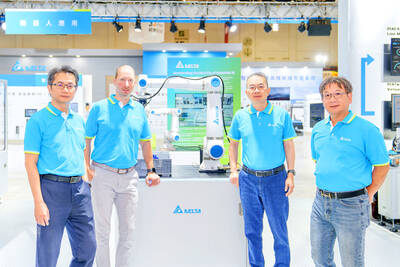Green Energy Technology Inc (綠能科技), the nation’s top solar wafer maker, yesterday said its gross margin would further expand this quarter because of rising output and higher prices on the back of global supply constraints.
The Taoyuan-based company’s factories have been running at full capacity since early this year on the back of a strong rebound in the solar business.
“We haven’t seen signs of a downcycle on the horizon,” Green Energy president Lin Hur-lon (林和龍) told investors. “The industry is still growing ... US and Asian markets are catching up with Europe and becoming new growth areas.”
This quarter, gross margin is expected to rise to more than 20 percent, from as high as 16 percent in the third quarter, after an expansion in output, chief executive Polar Hsieh (謝國雄) said.
Green Energy said annual capacity was expected to grow to 1.1 gigawatt at the end of the year, a spike of 57 percent from 700 megawatts in the third quarter.
The average selling price for solar wafers is expected to rise to US$3.70, from US$3.40, because of global supply constraints, the company said.
“Orders are 1.5-fold over our capacity,” Green Energy vice president Swean Lin (林士源) said.
To better satisfy customer demand, Green Energy plans to spend NT$5.9 billion, slightly higher than the NT$5.77 billion it originally planned, to build a new plant in southern Taiwan.
The new plant is scheduled to start operations in April.
Green Energy has not released audited third-quarter financial results yet, but the company expects net profits to be largely in line with a consensus forecast of NT$202 million (US$6.56 million), or NT$0.90 per share, after deducting NT$250 million in impairment costs from its convertible bonds issued on Oct. 24, 2008.
The impairment charges stem from the higher market value of its stock, which closed at NT$97.40 on Sept. 30, against its conversion price of NT$81.90 per share.
The company added that it had booked NT$50 million in foreign exchange losses because of the New Taiwan dollar’s appreciation against the US dollar, adding that a stronger currency would hurt its profits.
Each 1 percent rise in the NT dollar against the greenback would erode its net profit margin by 0.6 percentage points, it said.
The company said earlier this month that third-quarter revenues hit a record high at NT$46.18 billion, up 25 percent from NT$3.71 billion in the second quarter.

SETBACK: Apple’s India iPhone push has been disrupted after Foxconn recalled hundreds of Chinese engineers, amid Beijing’s attempts to curb tech transfers Apple Inc assembly partner Hon Hai Precision Industry Co (鴻海精密), also known internationally as Foxconn Technology Group (富士康科技集團), has recalled about 300 Chinese engineers from a factory in India, the latest setback for the iPhone maker’s push to rapidly expand in the country. The extraction of Chinese workers from the factory of Yuzhan Technology (India) Private Ltd, a Hon Hai component unit, in southern Tamil Nadu state, is the second such move in a few months. The company has started flying in Taiwanese engineers to replace staff leaving, people familiar with the matter said, asking not to be named, as the

The prices of gasoline and diesel at domestic fuel stations are to rise NT$0.1 and NT$0.4 per liter this week respectively, after international crude oil prices rose last week, CPC Corp, Taiwan (台灣中油) and Formosa Petrochemical Corp (台塑石化) announced yesterday. Effective today, gasoline prices at CPC and Formosa stations are to rise to NT$27.3, NT$28.8 and NT$30.8 per liter for 92, 95 and 98-octane unleaded gasoline respectively, the companies said in separate statements. The price of premium diesel is to rise to NT$26.2 per liter at CPC stations and NT$26 at Formosa pumps, they said. The announcements came after international crude oil prices

DOLLAR SIGNS: The central bank rejected claims that the NT dollar had appreciated 10 percentage points more than the yen or the won against the greenback The New Taiwan dollar yesterday fell for a sixth day to its weakest level in three months, driven by equity-related outflows and reactions to an economics official’s exchange rate remarks. The NT dollar slid NT$0.197, or 0.65 percent, to close at NT$30.505 per US dollar, central bank data showed. The local currency has depreciated 1.97 percent so far this month, ranking as the weakest performer among Asian currencies. Dealers attributed the retreat to foreign investors wiring capital gains and dividends abroad after taking profit in local shares. They also pointed to reports that Washington might consider taking equity stakes in chipmakers, including Taiwan Semiconductor

STABLE DEMAND: Delta supplies US clients in the aerospace, defense and machinery segments, and expects second-half sales to be similar to the first half Delta Electronics Inc (台達電) expects its US automation business to remain steady in the second half, with no signs of weakening client demand. With demand from US clients remaining solid, its performance in the second half is expected to be similar to that of the first half, Andy Liu (劉佳容), general manager of the company’s industrial automation business group, said on the sidelines of the Taiwan Automation Intelligence and Robot Show in Taipei on Wednesday. The company earlier reported that revenue from its automation business grew 7 percent year-on-year to NT$27.22 billion (US$889.98 million) in the first half, accounting for 11 percent